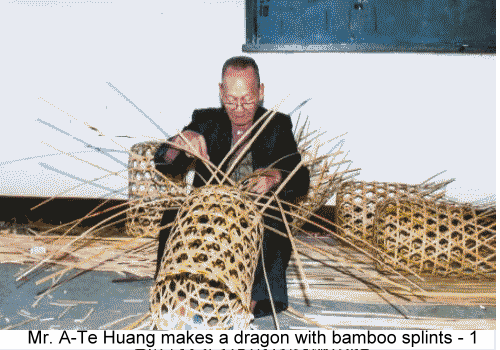| Pasting the Dragons | Dotting the Dragons’ Eyes | Welcoming the Dragons | Following the Dragons | Bombing the Dragons | Sending the Dragons Back to Heaven |
![]() The
Introduction
The
Introduction
There are six episodes in the whole “dragon-bombing festival”: pasting the dragons, dotting dragons’ eyes, welcoming the dragons, following the dragons, bombing the dragons and sending the dragons back to heaven. We can find from the custom that the position of dragons was placed between mortals and gods by Hakka ancestors. It reflects the Hakka people’s emotions and trust in the interaction between gods and common mortals. From inviting the “dragon god” to be a guest in the world of mortals, to help eliminate misfortunes and bestow blessings, to sending the “dragon god” back to heaven, the custom, practiced year after year, shows the relationship between the Hakka group and the “dragon god” is an intimate one. Their ancestors’ longing for the arrival of January 15th (the Lantern Festival) on the lunar calendar was also passed down. Miaoli citizens believe the more firecrackers they throw at the dragon, the more prosperous their New Year will be. Every year at this time, tens of thousands of firecrackers are thrown from all directions toward the dragons. The scene is filled with smoke, people as well as deafening drum and firecrackers. Everybody’s spirit is relatively high, bringing the Lantern Festival to a thunderous climax.
![]() Pasting
the Dragons
Pasting
the Dragons
In the agricultural era, the Hakka group in Miaoli would start to “paste dragons” after storing the harvest and before the Chinese New Year, so they could welcome the dragons on the Lantern Festival. The numbers of sections of the dragons needed to be decided first and then the material prepared accordingly. Miaoli is well known for its light but tough bamboo, which makes the dragon dance easier and more beautiful. People acquire the material locally due to the economical, convenient and practical aspects of bamboo.
The locations where dragons are pasted need to be chosen cautiously. After a dragon is pasted, it will be moved to a temple for the dotting of its eyes and be worshipped. This is a holy ritual; therefore, the location must be “clean,” in other words, without impurities. For the holiness of the dragons, it is taboo for women who are having periods, people who are in mourning, and babies (because they can evacuate at any time) to be near the dragons during the pasting process. After obtaining the material, the craftsman slices bamboo into splints to make the head and tail of the dragon. Then, he makes loops based on the number of sections, connects the loops, and covers the loops with a painted cloth. There can be any number of sections, but it must be an odd number (representing supremacy), and no more than 99. Most of the dragons in the Miaoli Hakka area have 9, 11 or 15 sections, which are auspicious numbers.
According to Hakka stories, there are five kinds of dragons (representing the five elements): golden dragon (golden or yellow color), silver dragon (silver or white), sea dragon (light blue), green dragon (green) and fire dragon (red). The selection of the “dragon cloth” depends on what kind of dragon will be made, and the length is based on the number of sections. After dragon scales are painted (or printed) on the cloth, fins and the belly are sewn on it. In general, 0.6 meters of red cloth is attached to the front of the dragon cloth, which symbolizes “welcoming the spring and good fortune,” and creates a flowing feeling when the head is moved. The main part of the dragon cloth should be in one piece, without being cut or sewn. After the dragon body is completed, the number of sections should not be shortened, or the person in charge will suffer from misfortunes.
To Hakka people in Miaoli, welcoming the dragon god on the 15th day of January is not only a symbol that brings good fortune and safety to them, but
also a way to celebrate the Lantern Festival. Therefore, they install lights in dragons, like lanterns. The luminous dragon bodies and bright eyes flying amid
smoke and firecrackers at night add more beauty to the Lantern Festival.
Because there were fewer entertainments and activities in early days, when a dragon was pasted, word would spread among local residents to watch it. During the pasting process, dragon dance team members, most of whom were young people on the farm, would be recruited. They started practicing the dragon dance on the 6th day of January and performed it at the Lantern Festival.
![]() Dragon-pasting
pictures
Dragon-pasting
pictures

![]() Data
source
Data
source
Many thanks to the Miaoli City Office for provision of photos and relevant text.
Contents also referred to the 2003-2008 Miaoli International Cultural Tourism Festival Proposal.
Data compilation: Shih-Min Lin, Wan-Ling Chen